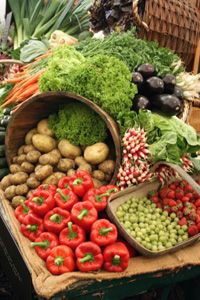 “Vegetables Image Gallery Eating healthy should begin early. See more vegetables pictures.©iStockphoto.com/AnnSteer
“Vegetables Image Gallery Eating healthy should begin early. See more vegetables pictures.©iStockphoto.com/AnnSteer
Eating can be one of life’s more enjoyable activities, and in the hunt for the perfect dessert, smoothie or burger, it’s easy to lose sight of the fact that food is made up of ingredients that your body needs to replenish and repair itself. To stay fit over the course of a lifetime, children and adults have to eat healthily, and even though the occasional lapse probably isn’t dangerous, paying attention to the quality of the food going into your body is important.
Nutrition Matters
Across the country, rates of child obesity and type 2 diabetes are soaring, and these conditions can have far-reaching implications. Children who eat a poor diet perform less well in school, and even though Americans have access to lots of great ingredients, many children are malnourished because they eat the wrong foods. Nutrition matters, and the old saying, "You are what you eat," was never truer than it is today [source: Seven Generations Ahead].
Food Geography
Food is a dynamic resource that’s essential for life. As consumers, we have power over the food choices we make. Your family probably understands about the importance of eating vegetables, fruits and lean meats, but there’s more to eating healthy than just stocking up from the produce department at your local market.
Because food is a worldwide commodity, the food in your grocery store could have originated across the street or across the globe. Those fresh strawberries you see in the middle of winter probably weren’t grown anywhere near where you live. In one way, this is nice, because having access to worldwide markets makes many fresh ingredients available year-round. In another way, those strawberries that look so tasty may be a poor choice most of the time.
When fresh foods travel to market, the whole process has to be carefully planned and monitored. Usually fresh products that have to travel long distances are limited to hearty varieties that aren’t very perishable. In the case of produce, fruits and vegetables may be picked when they’re still immature and have less nutritional value than their home-grown counterparts. Transporting and temporarily storing them in warehouses until they reach your market can use up valuable environmental resources too, like gasoline and electricity.
Buy Local
When you buy in-season foods from local farmers, you have access to ingredients that are fresh and ripe. You usually have more variety to choose from, too. Traditional markets may have eight or 10 kinds of apples for sale, but if you visit a local orchard or farmer’s market, there may be dozens of apple varieties on display. You’ll be able to experiment and choose the freshest, most flavorful foods when you take the time to look for locally grown, fresh ingredients for your meals. Experimenting with lots of different foods is also a good idea. If you enjoy variety in your diet, you’ll always be able to find something you like when it’s in season near you. This is a great way to eat right and support your local economy.
Buy Organic Products
The United States Department of Agriculture (USDA) certifies farms that grow organic products. These certified farms produce foods without the use of inorganic fertilizers and potentially dangerous pesticides. They also use environmentally responsible methods, like rotating their crops and using water wisely, that help protect wildlife and nearby ecosystems [source: Parnes].
When you use organic ingredients, you know that the foods you make and eat are wholesome and were produced in a way that’s humane and Earth friendly.
The next time you go shopping, look for the organic label on or near fruits, vegetables, eggs, milk, cheese and meat.
Did You Know?
There are levels in organic certification. Foods can be:
- 100 Percent Organic — This is the highest level of certification reserved for foods made up entirely of organic ingredients.
- Organic — This designation identifies foods with a minimum of 95 percent organic ingredients.
- Made with Organic Ingredients — A description reserved for foods composed of at least 70 percent organic ingredients. [source: USDA]
Read More
Lots More Information
Related HowStuffWorks Articles
- How Organic Food Works
- How Organic Farms Work
- How Organic Clothing Works
- How Mad Cow Disease Works
- How Vegans Work
- How Vegetarians Work
- Will there be farms in New York City’s skyscrapers?
- What are genetically modified (GM) foods?
Sources
- Colenso, Maria. "How Organic Certification Works." Undated. 9/5/09.https://recipes.howstuffworks.com/organic-certification.htm
- Duyff, Roberta L. MS, RD, FADA, CFCS. "Fruits and Vegetables: For the Nation’s Nutrition." Undated. 9/5/09.http://www.mealtime.org/content.aspx?id=326
- Kish, Stacy. "Fresh Food Program Promotes Healthy Eating Habits Among Children." USDA. 4/3/08. 9/5/09. http://www.csrees.usda.gov/newsroom/impact/2008/nri/04031_fresh_food.html
- Organic Farming Research Foundation. "About Organic." 2008. 9/4/09.http://ofrf.org/resources/organicfaqs.html
- Parnes, Robin Bret, "How Organic Food Works." Undated. 9/5/09.https://recipes.howstuffworks.com/organic-food.htm
- Seven Generations Ahead. "Fresh From the Farm." Undated. 9/3/09.http://www.sevengenerationsahead.org/fresh_from_the_farm.html
- USDA. "Organic Labeling and Marketing Information." 4/08. 9/4/09.http://www.ams.usda.gov/AMSv1.0/getfile?dDocName=STELDEV3004446














































